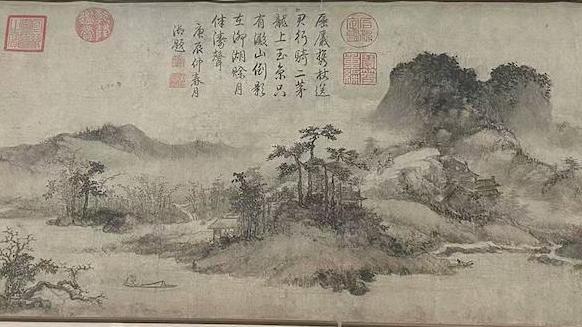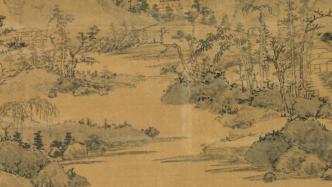

Following the opening of the Calligraphy Gallery and Painting Gallery at the East Pavilion of the Shanghai Museum, the "Psyche Art" team recently explored one of the latest exhibitions in the museum's collection of Chinese painting and calligraphy— the "Maritime Painting and Calligraphy Museum." This newly established gallery aims to trace the roots of Shanghai's painting and calligraphy through the lens of the "Shanghai School," analyzing the historical achievements of Shanghai painting and calligraphy from the perspective of literati paintings and assessing their significance and influence in the fine arts history.
The first round of exhibitions at the "Maritime Painting and Calligraphy Museum" features a total of 61 pieces, including 20 first-class items, accounting for one-third of the total. This gallery tells the achievements of a thousand years of maritime painting and calligraphy through works such as Mi Fu's "Running Script of the Dao Ancestor," Cao Zhibai's "Cool Green Evening Mist," Yang Weizhen's "草书录余善和张雨小游仙诗轴," Li Sheng's "Farewell at Lake Diao," Wen Jia's "Curved Water Garden," Dong Qichang's "Eight Scenes of Autumn," and Shen Yuan’s "Ice Play," among others. The gallery is set to open in November.

Maritime Painting and Calligraphy Museum
Maritime Painting and Calligraphy is Not the Same as "Shanghai School"
“Maritime painting and calligraphy is not synonymous with the 'Shanghai School.' Just one word difference marks the distinction between 2000 years and 200 years," said Ling Lizhong, director of the Shanghai Painting and Calligraphy Research Department. Historically, economically, and archaeologically, Shanghai is not a "small fishing village." However, public understanding of Shanghai's achievements in painting and calligraphy has remained confined to the notion of a "small fishing village," as people only recognize the "Shanghai School." After the opening of Shanghai in 1843, the "Shanghai School" gradually developed; it constitutes only a small part of the exhibition framework of the "Maritime Painting and Calligraphy Museum."
In 1958, with the administrative divisions adjustment, Shanghai's area expanded significantly, yet its cultural history, especially the history of painting and calligraphy in Shanghai, has not been adequately rewritten. From a painting and calligraphy perspective, the exhibition at the Maritime Painting and Calligraphy Museum systematically presents the regional art of Shanghai for the first time.

Northern Song Dynasty Mi Fu's "Running Script of the Dao Ancestor"
“I aim to clarify that Shanghai's achievements in painting and calligraphy do not equate to a 'small fishing village.' In the history of Jiangnan literati painting, this region is not just an edge case; it is indeed one of the cores." Ling Lizhong mentioned that the maritime painting and calligraphy history spans three peaks, closely accompanying every significant phase in the history of literati painting, including the "Mother of Manuals"—"Pingfu Tie," the achievements of literati painting in late Yuan Dynasty Shanghai, the early Ming's Yunqian School connected to Wu Men, and the final peak of ancient painting history represented by the Shanghai School and notable modern figures.

Yuan Dynasty Yang Weizhen's "草书录余善和张雨小游仙诗轴"
He candidly remarked that holding the grand exhibition of Dong Qichang was a "celebration" for the art community, while the creation of the Maritime Painting and Calligraphy Museum is akin to "archaeology of painting and calligraphy," which seeks to trace the cultural roots of the last 2000 years of Shanghai through the medium of painting and calligraphy. This is precisely the meaning indicated by the plaque at the entrance of the museum—"What is the Shanghai School?"
Gathering Nine Years of Academic Achievements in Painting and Calligraphy at the Shanghai Museum
The academic framework of the "Maritime Painting and Calligraphy Museum" stems from nine years of specialized research at the Shanghai Museum, particularly extending on the "Eternal Spring: Special Exhibition of Painting and Calligraphy Art Through the Ages in Shanghai." Highlights include rediscovering the achievements of the late Yuan and early Ming painting scene in Shanghai through comprehensive evaluations of individuals who have been overlooked by art history.

Ming Dynasty Ma Yu's "Scenery of the Capital" (Segment)

Yuan Dynasty Li Sheng's "Farewell at Lake Diao" (Shanghai Museum Collection)

Yuan Dynasty Li Sheng's "Farewell at Lake Diao" (Segment, Shanghai Museum Collection)

Local records of "Duan Mountain" detailing the twin mountains of Shanghai—"Duan Mountain" and "Ji Mountain"
The displayed piece "Farewell at Lake Diao" by Li Sheng from the Yuan Dynasty and “Curved Water Garden” by Wen Jia highlight the cultural migration routes of Shanghai since the Yuan and Ming periods. Li Sheng, a renowned painter at the end of the Yuan Dynasty from the Ho Liang region of Shandong, moved to the shores of Diao Lake in Shanghai in his later years. "Farewell at Lake Diao" is recognized as one of the earliest surviving depictions of the scenery at Qingpu’s Diao Lake, bearing significance similar to the anonymous Southern Song work "West Lake" and Huang Gongwang's "Dwelling in the Fuchun Mountains."
Wen Jia, the second son of Wen Zhengming, painted "Curved Water Garden” for his friend Dong Yiyang, showcasing the idyllic scenery of Dong's countryside residence. Dong was born into a prominent family in the Maqiao area of Minhang, Shanghai, and was well-versed in cultural and artistic pursuits, forming connections with literati and painters across Wu. The serene landscapes depicted by Wen Jia are a reflection of Dong Yiyang's ideal world, where he remained blissfully unaware of worldly conflicts.

Ming Dynasty Wen Jia's "Curved Water Garden" (Segment)
During the mid-Ming Dynasty, the collection activities in the Shanghai area mainly revolved around the four prominent families represented by "Gu, Lu, Zhang, and He." Displayed is a volume titled "Calligraphy Collection Manuscripts" by Lu Shen, which serves as a record of Lu's collection activities. Residing in Pudong, Lu Shen specialized in painting and calligraphy, boasting a rich collection. However, he was disinclined to stamp his works with titles, making it challenging to trace the full extent of his collection. This manuscript contains his notes on collecting from June to September during a certain year, revealing that within just three months, he obtained 89 pieces of painting and calligraphy from the Tang, Song, Yuan, and Ming periods, mainly by renowned artists such as Wang Wei, Han Gan, Li Gonglin, Guo Xi, Ma Hezheng, Zhao Mengfu, Huang Gongwang, and Wang Meng.

Lu Shen's "Calligraphy Collection Manuscripts" (Segment)
The Maritime Gallery also exhibits the complete album of Dong Qichang's "Eight Sceneries of Autumn," along with Qing Dynasty Zhang Qi and Xiang Shengmo’s "Friends of the Same Path," featuring two of Dong Qichang's "standard portraits," which are exceptionally rare.

Dong Wenmin's small portrait

Qing Dynasty Zhang Qi and Xiang Shengmo's "Friends of the Same Path"
Cultivating a Rich Cultural Atmosphere of the Shanghai School
The content of the "Shanghai School," most familiar to audiences, is presented in the final section of the Maritime Painting and Calligraphy Museum. This section discusses modern and contemporary Shanghai art from 1843 onwards, showcasing not only traditional Chinese painting but also oil paintings, watercolors, sketches, and works by foreigners depicting Chinese themes.

Exhibition Site

The Poet Tagore's gift of "Xu Zhimo Landscape with

